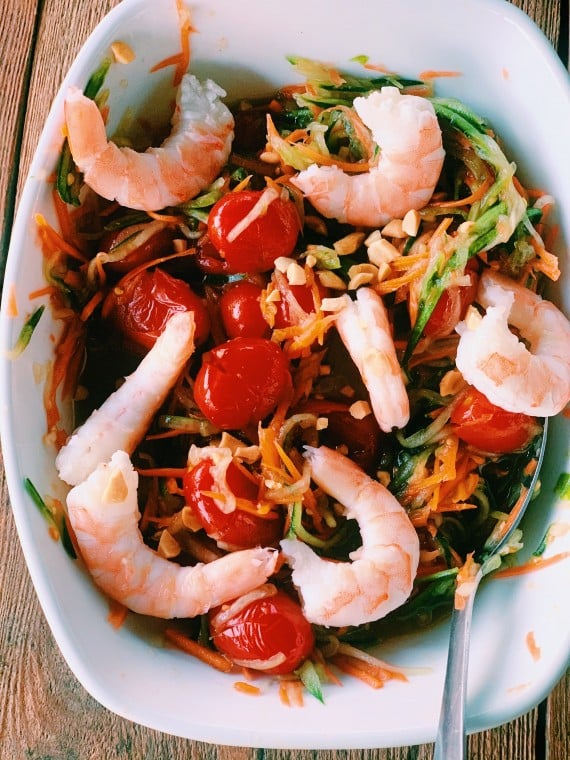“My friend gave me a stalk of lemongrass, and I just held it and stared at without a clue how to use it! What do I do??”One of my dear friends messaged me this recently, and I assured her that she wasn’t alone in her befuddlement at lemongrass.
Lemongrass freaked me out at first too, which is why it’s always one of the main Thai herbs I teach about during my Thai cooking class.
If you aren’t familiar with lemongrass, it has this amazing scent, I always say after you muddle it some it smells like Fruit Loops, and has a bright, citrus flavor that you find in many Thai soups like Tom Yum and Tom Kha Gai.
We grew some last year in our garden, I was shocked to see that it seriously looks like super tall, bright green grass, and the thick blades are so sharp that Thai Hubby and I have cut ourselves on them.
It’s nothing like how it looks when I buy it at the Asian store because as you see in these pics it just looks like a pale, yellow stalk.
To help you decode the mysterious ways of lemongrass, are some tips for working with lemongrass, one of my fav Thai herbs.
How to Cut Lemongrass
The trickiest part about working with lemongrass is figuring out what parts of it to actually use.
I always tell my students it’s a bummer because you actually don’t use much of the lemongrass.
First, you peel away the easy to take off layers of the lemongrass. Then when it starts to get harder to take it off the layers, STOP, and discard the layers you peeled off.
Then if you are making a Thai soup like Tom Yum Goong, or Tom Kha Gai, cut the stalk every two inches at angle, which helps to release the flavor.
Once you get to the part at the bottom that is hard to cut, stop cutting, and discard it. The top of the lemongrass that is flimsy and breaks off easily, can be discarded too.
So usually, depending how long your lemongrass is, you will be left with 6-7 two-inch long pieces of lemongrass that you will use in your soup.
How to Use Lemongrass
Then if you are making a Thai soup like Tom Yum or Tom Kha Gai, with the lemongrass, place it in a mortar and pestle to muddle it some.
Pound it with the pestle some just until it starts to splinter, but you don’t want to pulverize it. The goal is just to pound it a bit to help release the flavor. Once you start smelling more of its citrusy fragrance, stop.
If you don’t have a mortar and pestle, you can also use the side of a large chef’s knife to help soften it.
Place it under the largest part of the chef’s knife, and then slam down hard until it gives some, and you start to smell its wonders.
If you are using lemongrass for something like Tom Yum Fried Rice or Tom Yum Spaghetti, the lemongrass needs to be finely chopped. Chop the middle part of the lemongrass that’s easiest to chop as finely as possible.
If it’s too hard to break it down, try throwing it in the food processor.
Lemongrass Health Benefits
Lemongrass is like a bay leaf in Thai soups, it really is there just for flavor, and not typically eaten. If you accidentally chomp on some lemongrass stalk in your Tom Yum soup, you wont get sick if you eat it, it just is hard to chew.
But Thais don’t normally take it out of Thai soups because they know to eat around it, or they might munch on it because of the health benefits.
Lemongrass has way more health benefits than I expected:
- Good for digestion
- Full of antioxidants
- Regulates high blood pressure
- Boots metabolism and burns fat
- Great for skin and hair
- Helps heal your cold or flu
- Relieves menstrual pain
So through steeping the lemongrass in the soup, you get all these health benefits! Wow! Yet another reason Thai food is my favorite in the world!
If you have any more questions about lemongrass, I’d love to help. Feel free to contact me or DM me on Instagram!









I’ve been using lemongrass for years and didn’t know about the cutting at an angle thing! Every day is a school day, right?! Thanks 🙂
Love that you got to learn something new! I feel like every week I learn something new about Thai cooking, and love it too! 🙂